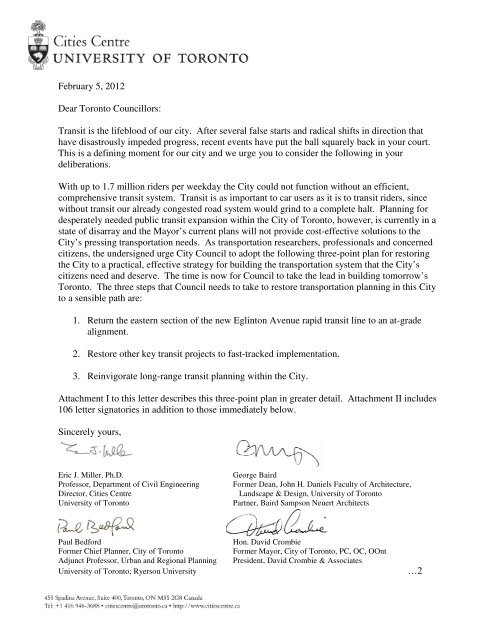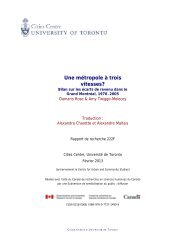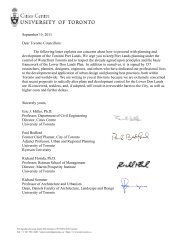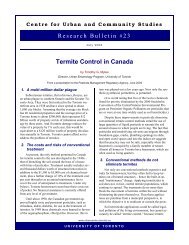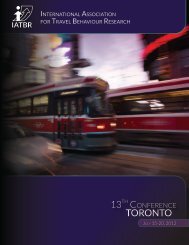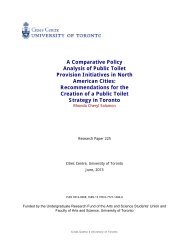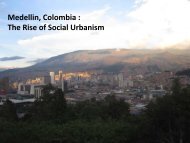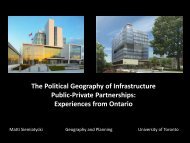Letter - Cities Centre - University of Toronto
Letter - Cities Centre - University of Toronto
Letter - Cities Centre - University of Toronto
Create successful ePaper yourself
Turn your PDF publications into a flip-book with our unique Google optimized e-Paper software.
February 5, 2012<br />
Dear <strong>Toronto</strong> Councillors:<br />
Transit is the lifeblood <strong>of</strong> our city. After several false starts and radical shifts in direction that<br />
have disastrously impeded progress, recent events have put the ball squarely back in your court.<br />
This is a defining moment for our city and we urge you to consider the following in your<br />
deliberations.<br />
With up to 1.7 million riders per weekday the City could not function without an efficient,<br />
comprehensive transit system. Transit is as important to car users as it is to transit riders, since<br />
without transit our already congested road system would grind to a complete halt. Planning for<br />
desperately needed public transit expansion within the City <strong>of</strong> <strong>Toronto</strong>, however, is currently in a<br />
state <strong>of</strong> disarray and the Mayor’s current plans will not provide cost-effective solutions to the<br />
City’s pressing transportation needs. As transportation researchers, pr<strong>of</strong>essionals and concerned<br />
citizens, the undersigned urge City Council to adopt the following three-point plan for restoring<br />
the City to a practical, effective strategy for building the transportation system that the City’s<br />
citizens need and deserve. The time is now for Council to take the lead in building tomorrow’s<br />
<strong>Toronto</strong>. The three steps that Council needs to take to restore transportation planning in this City<br />
to a sensible path are:<br />
1. Return the eastern section <strong>of</strong> the new Eglinton Avenue rapid transit line to an at-grade<br />
alignment.<br />
2. Restore other key transit projects to fast-tracked implementation.<br />
3. Reinvigorate long-range transit planning within the City.<br />
Attachment I to this letter describes this three-point plan in greater detail. Attachment II includes<br />
106 letter signatories in addition to those immediately below.<br />
Sincerely yours,<br />
Eric J. Miller, Ph.D.<br />
Pr<strong>of</strong>essor, Department <strong>of</strong> Civil Engineering<br />
Director, <strong>Cities</strong> <strong>Centre</strong><br />
<strong>University</strong> <strong>of</strong> <strong>Toronto</strong><br />
George Baird<br />
Former Dean, John H. Daniels Faculty <strong>of</strong> Architecture,<br />
Landscape & Design, <strong>University</strong> <strong>of</strong> <strong>Toronto</strong><br />
Partner, Baird Sampson Neuert Architects<br />
Paul Bedford<br />
Hon. David Crombie<br />
Former Chief Planner, City <strong>of</strong> <strong>Toronto</strong><br />
Former Mayor, City <strong>of</strong> <strong>Toronto</strong>, PC, OC, OOnt<br />
Adjunct Pr<strong>of</strong>essor, Urban and Regional Planning President, David Crombie & Associates<br />
<strong>University</strong> <strong>of</strong> <strong>Toronto</strong>; Ryerson <strong>University</strong> …2
Ken Greenberg<br />
Principal, Greenberg Consultants Inc.<br />
Paul Hess, Ph.D.<br />
Associate Pr<strong>of</strong>essor, Department <strong>of</strong> Geography<br />
Director, Graduate Program in Planning<br />
<strong>University</strong> <strong>of</strong> <strong>Toronto</strong><br />
Ed Levy<br />
Former President and Chairman<br />
BA Consulting Group Ltd.<br />
Andy Manahan<br />
Executive Director<br />
Residential and Civil Construction<br />
Alliance <strong>of</strong> Ontario<br />
Amer Shalaby, Ph.D.<br />
Associate Pr<strong>of</strong>essor,<br />
Department <strong>of</strong> Civil Engineering<br />
Chair, Urban Transportation Research &<br />
Advancement <strong>Centre</strong>, <strong>University</strong> <strong>of</strong> <strong>Toronto</strong><br />
Richard M, Soberman, Ph.D.<br />
Pr<strong>of</strong>essor Emeritus & Former Chair<br />
Department <strong>of</strong> Civil Engineering<br />
Uiversity <strong>of</strong> <strong>Toronto</strong><br />
Andre Sorensen, Ph.D.<br />
Associate Pr<strong>of</strong>essor <strong>of</strong> Urban Geography<br />
<strong>University</strong> <strong>of</strong> <strong>Toronto</strong>, Scarborough<br />
2
ATTACHMENT I<br />
A THREE-POINT PLAN FOR IMPROVED TRANSIT IN THE<br />
CITY OF TORONTO<br />
1. Return the eastern section <strong>of</strong> the new Eglinton Avenue rapid transit line to an at-grade<br />
alignment. High quality rapid transit along Eglinton Avenue is absolutely essential to the<br />
development <strong>of</strong> an improved transit network within the City. This was recognized in the<br />
Metrolinx “Big Move” regional transportation plan through the designation <strong>of</strong> Eglinton as a<br />
priority corridor for immediate investment. The decision to bury the central section <strong>of</strong> this line,<br />
although costly, can be justified given the land use density and the relatively narrow roadway<br />
along this portion <strong>of</strong> the corridor. The current plan for the portion <strong>of</strong> the route east <strong>of</strong> Brentcliffe<br />
Road to also be buried underground, however, is not sensible for many reasons including:<br />
• The roadway rights-<strong>of</strong>-way along these suburban roadways are very generous and<br />
provide ample room for an at-grade alignment. Plenty <strong>of</strong> room remains to accommodate<br />
car and truck traffic.<br />
• A well-designed LRT line will carry many more people per hour than a lane <strong>of</strong> roadway.<br />
Furthermore, no road capacity need be sacrificed along these portions <strong>of</strong> the route: the<br />
generous road allowances can provide for both the existing number <strong>of</strong> lanes and the new<br />
LRT line. The objective <strong>of</strong> any transportation system is to move people, not vehicles.<br />
Building at-grade LRT lanes does not constitute a “war on cars”, rather it represents a<br />
way <strong>of</strong> maximizing mobility for trip-makers travelling in the corridor.<br />
• Forcing all higher-order transit underground as a matter <strong>of</strong> principle is a misguided<br />
policy. It ensures that most transit expansions become prohibitively expensive and<br />
cannot be justified on the basis <strong>of</strong> the number <strong>of</strong> people the system will carry. The result<br />
is that we end up building much less transit than we need because we spend our precious<br />
dollars on artificially expensive underground lines when much more cost-effective atgrade<br />
solutions exist. To say that we need to bury all higher-order transit lines because<br />
people “like” subways misstates the issue. What people want is reliable, frequent service<br />
that takes them where they need to go. People “like” subways because they generally<br />
provide such frequent, reliable service. They will also “like” other technologies that<br />
provide similar service levels, whether they are underground or not. Indeed, there is<br />
nothing fundamentally attractive about having to go underground in order to make a trip.<br />
Transit lines should be buried only when necessary – i.e., when economically and<br />
operationally justified – not as a matter <strong>of</strong> abstract principle.<br />
• Eglinton Avenue is a prime example <strong>of</strong> the wastefulness <strong>of</strong> this policy. Quite literally<br />
billions <strong>of</strong> dollars are going to be needlessly spent burying the suburban portions <strong>of</strong> this<br />
line, with very limited benefit to a limited number <strong>of</strong> trip-makers. As noted by John<br />
Lorinc in a recent Spacing article, the current plan to bury all <strong>of</strong> Eglinton has not been<br />
subjected to any form <strong>of</strong> cost-benefit analysis. 1 If such an analysis was undertaken it<br />
would surely demonstrate the clear inefficiency <strong>of</strong> the plan. No private-sector firm would<br />
be so wasteful in its use <strong>of</strong> company resources. These billions can and should instead be<br />
spent building other much-needed transit lines in other corridors within the City. Tens <strong>of</strong><br />
1<br />
http://spacingtoronto.ca/2012/01/30/lorinc-whos-going-to-be-the-grown-up-on-the-eglinton-crosstown/.<br />
3
thousands <strong>of</strong> people are going to be denied improved transit services if this decision is<br />
not reversed.<br />
• We firmly believe that no knowledgeable transportation pr<strong>of</strong>essional would support such<br />
an inefficient and unnecessary proposal for a transit line. To our knowledge no such<br />
pr<strong>of</strong>essional endorsement <strong>of</strong> this plan exists. It is the obligation <strong>of</strong> Council to ensure that<br />
such momentous decisions are properly considered and properly supported by sound<br />
pr<strong>of</strong>essional analysis and advice before billions <strong>of</strong> taxpayers’ dollars are needlessly spent.<br />
2. Restore key transit projects to fast-tracked implementation. The saving <strong>of</strong> billions <strong>of</strong><br />
dollars through restoring the suburban portions <strong>of</strong> the Eglinton LRT line to a surface alignment<br />
makes possible the fast-tracking <strong>of</strong> several other desperately needed transit capital projects<br />
within the City. These savings must not be taken back by the Province for allocation to other<br />
purposes (debt reduction, etc.). This money was and is committed to transit improvements<br />
within the City and this commitment must be maintained. What we are arguing for in this letter<br />
is a far more effective employment <strong>of</strong> these precious committed dollars to maximize their impact<br />
on improving transit within the City (which, again, is <strong>of</strong> regional as well as local importance<br />
given <strong>Toronto</strong>’s central place within the GTHA). Previously planned, approved and prioritized<br />
projects which should be reinstated for implementation are:<br />
• Construction <strong>of</strong> higher-order transit on Finch Avenue West. In 2011 Finch West carried<br />
38,100 riders per day 2 (comparable to ridership levels on the Carlton and Dundas<br />
streetcar lines and only about 10,000 fewer riders per day than the Sheppard Subway) and<br />
urgently needs upgrading to a higher-order transit service.<br />
• Higher-order transit extension <strong>of</strong> Sheppard East. Connection <strong>of</strong> Victoria Park (and its<br />
north-south transit lines), the Consumers Road employment district and central<br />
Scarborough to the existing Sheppard subway line is an important component <strong>of</strong> building<br />
an improved transit network in Scarborough.<br />
• Conversion <strong>of</strong> the Scarborough Rapid Transit (SRT) line to LRT. SRT vehicles are<br />
reaching the end <strong>of</strong> their service lives, the line is approaching capacity, and an upgrade <strong>of</strong><br />
the line to LRT is another critical component in improving the Scarborough network.<br />
3. Reinvigorate long-range transit planning within the City. Looking beyond the very<br />
pressing need to make wise decisions immediately concerning the three key east-west corridors<br />
Eglinton, Sheppard and Finch, in the medium term a comprehensive plan for the <strong>Toronto</strong> transit<br />
network is desperately needed. Ad hoc, one <strong>of</strong>f decisions are no way to build a cost-effective,<br />
attractive transit network. Network connectivity and coverage are critical to providing transit<br />
services that are maximally useful, as is the thoughtful matching <strong>of</strong> the supply <strong>of</strong> services to<br />
meet the spatial patterns <strong>of</strong> current and future travel demand. A systematic review and analysis<br />
<strong>of</strong> past, current and new plans and ideas is urgently required so that we have a thoughtful,<br />
defensible, cost-effective plan for moving forward in the longer term and so that we never again<br />
fall into the chaos in which we currently find ourselves. This will involve making decisions<br />
about other important corridors within the City, notably a downtown relief line, north-south<br />
lines, the Waterfront LRT line, and others. But these decisions need to be made within a<br />
comprehensive planning process, not as a series <strong>of</strong> independent, ad hoc decisions.<br />
2<br />
http://www3.ttc.ca/PDF/Transit_Planning/Ridership_and_cost_statistics_for_bus_and_streetca_routes_20.pdf<br />
4
Planning is a continuous process, not a one-shot deal. The problem is not that we have done too<br />
many planning studies, it's that very little has been implemented from most <strong>of</strong> these studies and<br />
at the same time we have lost sight <strong>of</strong> the big picture. We need to restore a commitment to longrange<br />
network planning (prioritization <strong>of</strong> funding, integrating land use and transit investment) or<br />
we will just continue to muddle through project-by-project, horse-trading our way from one<br />
crisis to the next, missing opportunities and wasting time and precious resources.<br />
One model for such a study is the Metropolitan <strong>Toronto</strong> Transportation Plan Review (MTTPR)<br />
which was undertaken in the mid-1970s. At the time Metro <strong>Toronto</strong>’s transportation plans were<br />
in a somewhat similar confused state due to the cancellation <strong>of</strong> expressway plans for the city and<br />
the failure <strong>of</strong> a transit scheme proposed by the provincial government to provide a feasible<br />
alternative to the cancelled expressways. Planners from Metro, the TTC, the Ontario Ministry <strong>of</strong><br />
Transportation and Communications, academia and the private sector all worked together to<br />
develop a new comprehensive plan for Metro <strong>Toronto</strong>. A similar team, consisting <strong>of</strong> staff from<br />
the City, TTC, Metrolinx, academia, and other experts, provided with a clear mandate from<br />
Council, could provide to Council the independent, pr<strong>of</strong>essional, comprehensive plan for its<br />
approval that is needed to move beyond the personal preference approach, overly politicized<br />
environment in which we currently find ourselves and to provide a sound framework for moving<br />
the City’s transportation agenda forward over the longer term.<br />
Concluding Remarks<br />
The current emphasis on investing all transit capital funds to unnecessarily bury all <strong>of</strong> the<br />
Eglinton LRT line and pushing ahead with an unjustified Sheppard subway line to the exclusion<br />
<strong>of</strong> a more balanced, cost-effective transit plan that would benefit vastly greater numbers <strong>of</strong><br />
<strong>Toronto</strong>nians is unsupportable. It will inflict punitive social costs on large numbers <strong>of</strong> our<br />
citizens who will receive no relief from unacceptably poor transit service and unremitting<br />
congestion on our roadways.<br />
The current policy is radically out <strong>of</strong> sync with best practice in cities around the world<br />
(Vancouver, Montreal, Calgary, New York, Boston, Los Angeles, Munich, Berlin, Stockholm,<br />
Madrid, London – the list goes on and on) which are: (a) succeeding in shifting modal shares in<br />
favour <strong>of</strong> transit (and non-motorized modes as well) while not disadvantaging drivers (i.e., they<br />
are making things better for all trip-makers), and (b) using a range <strong>of</strong> appropriate technologies to<br />
do this, matching technology to need, rather than insisting on a “one-size fits all” approach,<br />
regardless <strong>of</strong> facts, needs or costs. In particular, LRT and BRT technologies are being used<br />
world-wide to cost-effectively provide transit services that are competitive to the automobile,<br />
with these services being matched to land use densities, travel demand patterns and network<br />
configurations as required. If <strong>Toronto</strong> is to compete successfully with these world cities, then it<br />
must aggressively pursue a rational, best-practice, well-designed transit policy.<br />
At the moment, our transit policy falls far short <strong>of</strong> these needs. We can still reverse this<br />
unfortunate situation, but we must act now before billions are wasted, opportunities are lost and a<br />
congestion-induced irreversible downward slide in our productivity, growth and quality <strong>of</strong> life<br />
occurs. <strong>Toronto</strong>’s success as a global city is not foreordained. We need to work on it day-byday,<br />
in every decision we make. Let’s make the best ones possible with respect to our transit<br />
system!<br />
5
ATTACHMENT II<br />
ADDITIONAL SIGNATORIES<br />
Ron Buliung<br />
Associate Pr<strong>of</strong>essor<br />
<strong>Cities</strong> <strong>Centre</strong>, Univ. <strong>Toronto</strong><br />
David A. Wolfe<br />
Pr<strong>of</strong>essor, Political Science<br />
<strong>University</strong> <strong>of</strong> <strong>Toronto</strong><br />
Zack Taylor<br />
Doctoral Candidate and Consulting<br />
Researcher<br />
<strong>University</strong> <strong>of</strong> <strong>Toronto</strong><br />
Susannah Bunce<br />
Assistant Pr<strong>of</strong>essor<br />
<strong>University</strong> <strong>of</strong> <strong>Toronto</strong> Scarborough<br />
Elizabeth S. Cohen<br />
Pr<strong>of</strong>essor<br />
York <strong>University</strong><br />
Nabil Malik<br />
President<br />
Federation <strong>of</strong> Urban Studies Students, York <strong>University</strong><br />
J. David Hulchanski Marvin Macaraig<br />
Ph.D. Candidate, Department <strong>of</strong> Geography and<br />
Associate Director for Research<br />
Program in Planning, <strong>University</strong> <strong>of</strong> <strong>Toronto</strong><br />
2010 City Councillor Candidate, Ward 36, Scarborough<br />
<strong>Cities</strong> <strong>Centre</strong>, <strong>University</strong> <strong>of</strong> <strong>Toronto</strong><br />
Southwest<br />
Shauna Brail<br />
Senior Lecturer<br />
<strong>University</strong> <strong>of</strong> <strong>Toronto</strong>, Urban Studies Program<br />
Cynthia Wilkey<br />
Chair<br />
West Don Lands Committee<br />
Brian Iler<br />
Chair<br />
CommunityAIR<br />
Morgan Skowronski<br />
MScPlanning<br />
<strong>University</strong> <strong>of</strong> <strong>Toronto</strong><br />
David Buchbinder<br />
CEO/Artistic Director<br />
Diasporic Genius<br />
Ruddick Susan<br />
Associate Pr<strong>of</strong>essor<br />
Department <strong>of</strong> Geography and Program in<br />
Planning<br />
Rana Masoudi<br />
Masters Student<br />
<strong>University</strong> <strong>of</strong> <strong>Toronto</strong><br />
Jacob Etches<br />
PhD<br />
Resident<br />
Matthew Roorda<br />
Associate Pr<strong>of</strong>essor<br />
Civil Engineering, <strong>University</strong> <strong>of</strong> <strong>Toronto</strong><br />
Sharon McElroy<br />
EPRA<br />
Faye Mishna<br />
Dean & Pr<strong>of</strong>essor<br />
Factor-inwentash Faculty <strong>of</strong> Social Work, <strong>University</strong> <strong>of</strong><br />
<strong>Toronto</strong><br />
Kathryn Grond<br />
Urban Infrastructure Research Coordinator<br />
<strong>Cities</strong> <strong>Centre</strong>, <strong>University</strong> <strong>of</strong> <strong>Toronto</strong><br />
6
Ken MacDonald<br />
Assistant Pr<strong>of</strong>essor<br />
Dept.<strong>of</strong> Geography and Program in Planning,<br />
<strong>University</strong> <strong>of</strong> <strong>Toronto</strong><br />
Adrian Lightstone<br />
Economist<br />
Private Sector<br />
Tenley Conway<br />
Associate Pr<strong>of</strong>essor<br />
<strong>University</strong> <strong>of</strong> <strong>Toronto</strong>, Mississauga<br />
Danyluk Martin<br />
Ph.D. student<br />
Department <strong>of</strong> Geography, <strong>University</strong> <strong>of</strong><br />
<strong>Toronto</strong><br />
Carol Moukheiber<br />
Director, Master <strong>of</strong> Urban Design<br />
DFALD, <strong>University</strong> <strong>of</strong> <strong>Toronto</strong><br />
Seasons Mark<br />
Associate Pr<strong>of</strong>essor<br />
School <strong>of</strong> Planning, <strong>University</strong> <strong>of</strong> Waterloo<br />
Larry S. Bourne<br />
Pr<strong>of</strong>essor emeritus, Geography and Planning,<br />
Senior Advisor, <strong>Cities</strong> <strong>Centre</strong><br />
<strong>University</strong> <strong>of</strong> <strong>Toronto</strong><br />
Sheila Neysmith<br />
Associate Dean Research FIFSW, RBC Chair<br />
in Applied Social Work Research<br />
<strong>University</strong> <strong>of</strong> <strong>Toronto</strong><br />
Guinevere Ngau<br />
Transportation Engineer<br />
HDR Corporation<br />
Roger Keil<br />
Director and Pr<strong>of</strong>essor<br />
The City Institute at York <strong>University</strong><br />
Kim Solga<br />
Associate Pr<strong>of</strong>essor<br />
Western <strong>University</strong><br />
Lake Sagaris<br />
active citizen, PhD candidate, Urban planning,<br />
<strong>University</strong> <strong>of</strong> <strong>Toronto</strong><br />
Brigitte Shim<br />
Associate Pr<strong>of</strong>essor<br />
John H. Daniels Faculty <strong>of</strong> Architecture, Landscape,<br />
and Design, <strong>University</strong> <strong>of</strong> <strong>Toronto</strong><br />
Ilan Kapoor<br />
Pr<strong>of</strong>essor<br />
Faculty <strong>of</strong> Environmental Studies, York <strong>University</strong>,<br />
<strong>Toronto</strong><br />
Aron Shlonsky<br />
Pr<strong>of</strong>essor<br />
Univeristy <strong>of</strong> <strong>Toronto</strong><br />
Izumi Sakamoto<br />
Associate Pr<strong>of</strong>essor<br />
<strong>University</strong> <strong>of</strong> <strong>Toronto</strong><br />
Alan Walks<br />
Associate Pr<strong>of</strong>essor<br />
<strong>University</strong> <strong>of</strong> <strong>Toronto</strong><br />
Alex Speigel<br />
President<br />
ONE Development / ideas Development<br />
Tong Lam<br />
Associate Pr<strong>of</strong>essor <strong>of</strong> History<br />
<strong>University</strong> <strong>of</strong> <strong>Toronto</strong><br />
Richard Harris<br />
Pr<strong>of</strong>essor<br />
McMaster <strong>University</strong><br />
Brent Berry<br />
Associate Pr<strong>of</strong>essor, Department <strong>of</strong> Sociology<br />
<strong>University</strong> <strong>of</strong> <strong>Toronto</strong><br />
Matthew Farish<br />
Associate Pr<strong>of</strong>essor<br />
Department <strong>of</strong> Geography, <strong>University</strong> <strong>of</strong> <strong>Toronto</strong><br />
7
Clement Kent<br />
Postdoctoral Fellow<br />
York <strong>University</strong><br />
McClelland Michael<br />
Principal<br />
ERA Architects<br />
Donald Jackson<br />
Pr<strong>of</strong>essor and Interim Director<br />
<strong>Centre</strong> for Environment, U<strong>of</strong>T<br />
Graeme Stewart<br />
Associate<br />
ERA Architects Inc., <strong>Centre</strong> for Urban Growth<br />
and Renewal<br />
Thomas Cohen<br />
Chair<br />
Eglinton Park Res. Assoc.<br />
Jody Berland<br />
Pr<strong>of</strong>essor<br />
Robarts <strong>Centre</strong> for Canadian Studies, York<br />
<strong>University</strong><br />
John Campey<br />
Executive Director<br />
Social Planning <strong>Toronto</strong><br />
Karen Mundy<br />
Associate Pr<strong>of</strong>essor<br />
<strong>University</strong> <strong>of</strong> <strong>Toronto</strong><br />
Douglas Duckworth<br />
MScPl 2012 Candidate<br />
<strong>University</strong> <strong>of</strong> <strong>Toronto</strong><br />
Scott Sams<br />
Ph.D. Candidate, Department <strong>of</strong> Political<br />
Science & Graduate Associate, <strong>Cities</strong> <strong>Centre</strong><br />
<strong>University</strong> <strong>of</strong> <strong>Toronto</strong><br />
Robert Warren<br />
Director<br />
Eglinton Park Residents' Association<br />
BETH SAVAN<br />
<strong>University</strong> <strong>of</strong> <strong>Toronto</strong> <strong>Cities</strong> <strong>Centre</strong><br />
Dylan Reid<br />
Research affiliate<br />
<strong>Cities</strong> <strong>Centre</strong>, <strong>University</strong> <strong>of</strong> <strong>Toronto</strong><br />
Matthew Blackett<br />
Publisher<br />
Spacing<br />
Peter Broadley<br />
Citizen<br />
Frances Frisken<br />
Pr<strong>of</strong>essor Emerita<br />
York <strong>University</strong><br />
Bryan Dale<br />
Graduate Student<br />
<strong>University</strong> <strong>of</strong> <strong>Toronto</strong><br />
Charles Hostovsky, PhD, MCIP<br />
Consultant<br />
Self-Employed<br />
Mark Langridge<br />
Architect<br />
<strong>Toronto</strong><br />
Andrew Sancton<br />
Pr<strong>of</strong>essor <strong>of</strong> Political Science<br />
<strong>University</strong> <strong>of</strong> Western Ontario<br />
Beth Moore Milroy<br />
PhD, Pr<strong>of</strong>essor Emerita<br />
School <strong>of</strong> Urban & Regional Planning, Ryerson<br />
<strong>University</strong><br />
Adrian Blackwell<br />
Assistant Pr<strong>of</strong>essor<br />
Daniels Faculty <strong>of</strong> Architecture, Landscape, and<br />
Design<br />
8
Nancy Warren<br />
<strong>Toronto</strong> Taxpayer<br />
Gerda Wekerle<br />
Pr<strong>of</strong>essor, Coordinator <strong>of</strong> Planning Programs<br />
Faculty <strong>of</strong> Environmental Studies, York<br />
<strong>University</strong><br />
Jack Quarter<br />
Pr<strong>of</strong>essor<br />
Social Economy <strong>Centre</strong>, OISE<br />
Barry Wellman, FRSC<br />
S.D. Clark Pr<strong>of</strong>essor<br />
Department <strong>of</strong> Sociology, <strong>University</strong> <strong>of</strong><br />
<strong>Toronto</strong><br />
Joseph Clement<br />
Art Director<br />
Directors Guild <strong>of</strong> Canada<br />
Carol Annett<br />
CEO<br />
VHA Home HealthCare<br />
Richard DiFrancesco<br />
Associate Pr<strong>of</strong>essor<br />
Dept. Of Geography and Program in Planning<br />
Gene Desfor<br />
Pr<strong>of</strong>essor Emeritus<br />
York <strong>University</strong><br />
Mettke Christian<br />
Dipl. Geograph<br />
Darmstadt <strong>University</strong> <strong>of</strong> Technology<br />
Janine Marchessault<br />
Pr<strong>of</strong>essor<br />
York <strong>University</strong><br />
Robert Murdie<br />
Pr<strong>of</strong>essor Emeritus<br />
York <strong>University</strong><br />
John Gladki<br />
Principal Planner<br />
Gladki Planning Associates<br />
Mohammad Qadeer<br />
Pr<strong>of</strong>essor Emeritus<br />
Queen's <strong>University</strong><br />
Tracey Winton<br />
Assistant Pr<strong>of</strong>essor<br />
<strong>University</strong> <strong>of</strong> Waterloo<br />
Diego Almaraz<br />
Student Planner<br />
Region <strong>of</strong> Waterloo<br />
Ge<strong>of</strong>f Bagga<br />
Student<br />
Laura Taylor<br />
Assistant Pr<strong>of</strong>essor<br />
York <strong>University</strong><br />
John Danahy<br />
Pr<strong>of</strong>essor<br />
<strong>Centre</strong> for Landscape Research, John H Daniels<br />
Faculty <strong>of</strong> Architecture, Landscape, and Design, U<strong>of</strong>T<br />
Louna (Luna) Khirfan<br />
Assistant Pr<strong>of</strong>essor<br />
The <strong>University</strong> <strong>of</strong> Waterloo, School <strong>of</strong> Planning<br />
Newsha Ghaeli<br />
Architect<br />
worked with faculty at U<strong>of</strong>T<br />
Mahboubi Mateen<br />
Transportation Analyst<br />
IBI Group<br />
Marianne Touchie<br />
Ph.D. Candidate<br />
<strong>University</strong> <strong>of</strong> <strong>Toronto</strong><br />
9
Mark Winfield<br />
Associate Pr<strong>of</strong>essor<br />
Faculty <strong>of</strong> Environmental Studies, York<br />
<strong>University</strong><br />
Warren Crichlow<br />
Associate Pr<strong>of</strong>essor<br />
York <strong>University</strong><br />
Philip Webb<br />
Research Associate<br />
<strong>Cities</strong> <strong>Centre</strong>, U <strong>Toronto</strong><br />
Ute Lehrer<br />
Associate Pr<strong>of</strong>essor<br />
York <strong>University</strong><br />
Meric Gertler<br />
Pr<strong>of</strong>essor <strong>of</strong> Geography and Planning<br />
<strong>University</strong> <strong>of</strong> <strong>Toronto</strong><br />
Martin Horak<br />
Associate Pr<strong>of</strong>essor, Department <strong>of</strong> Political<br />
Science<br />
<strong>University</strong> <strong>of</strong> Western Ontario<br />
Cristina Amon<br />
Dean, Applied Science & Engineering<br />
<strong>University</strong> <strong>of</strong> <strong>Toronto</strong><br />
Douglas Young<br />
Associate Pr<strong>of</strong>essor<br />
York <strong>University</strong><br />
Katharine Rankin<br />
Pr<strong>of</strong>essor<br />
<strong>University</strong> <strong>of</strong> <strong>Toronto</strong> Geography<br />
Melissa Yu<br />
Project Manager<br />
Evergreen<br />
Benji Wong<br />
student<br />
Brian Turner<br />
Director, Clinical Informatics<br />
Mount Sinai Hospital<br />
Mariana Valverde<br />
Pr<strong>of</strong>essor<br />
<strong>University</strong> <strong>of</strong> <strong>Toronto</strong><br />
Adam Scott<br />
Roxana Ng<br />
Pr<strong>of</strong>essor<br />
<strong>University</strong> <strong>of</strong> <strong>Toronto</strong><br />
Sonya Jensen<br />
Project Manager<br />
Lundholm Associates Architects<br />
Nancy Smith Lea<br />
Director<br />
<strong>Toronto</strong> <strong>Centre</strong> for Active Transportation<br />
Ekaterina Tzekova<br />
Ph.D. Candidate<br />
Department <strong>of</strong> Civil Engineering, <strong>University</strong> <strong>of</strong> <strong>Toronto</strong><br />
Anna Cote<br />
MES Planning Candidate,<br />
York <strong>University</strong><br />
10


